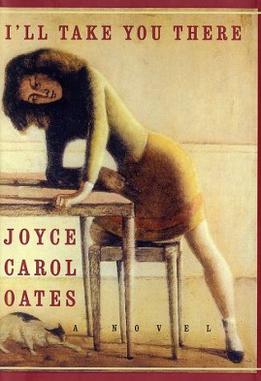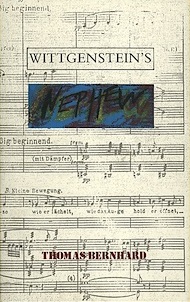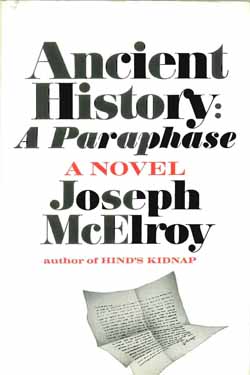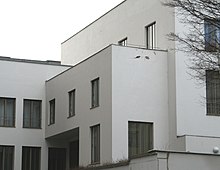
Ludwig Josef Johann Wittgenstein was an Austrian-born British philosopher who worked primarily in logic, the philosophy of mathematics, the philosophy of mind, and the philosophy of language.

Ingeborg Bachmann was an Austrian poet and author. She is regarded as one of the major voices of German-language literature in the 20th century.
A first-person narrative is a mode of storytelling in which a storyteller recounts events from that storyteller's own personal point of view, using first-person grammar such as "I", "me", "my", and "myself". It must be narrated by a first-person character, such as a protagonist, re-teller, witness, or peripheral character. Alternatively, in a visual storytelling medium, the first-person perspective is a graphical perspective rendered through a character's visual field, so the camera is "seeing" out of a character's eyes.

Paul Wittgenstein was an Austrian-American concert pianist notable for commissioning new piano concerti for the left hand alone, following the amputation of his right arm during the First World War. He devised novel techniques, including pedal and hand-movement combinations, that allowed him to play chords previously regarded as impossible for a five-fingered pianist.

A Portrait of the Artist as a Young Man is the first novel of Irish writer James Joyce, published in 1916. A Künstlerroman written in a modernist style, it traces the religious and intellectual awakening of young Stephen Dedalus, Joyce's fictional alter ego, whose surname alludes to Daedalus, Greek mythology's consummate craftsman. Stephen questions and rebels against the Catholic and Irish conventions under which he has grown, culminating in his self-exile from Ireland to Europe. The work uses techniques that Joyce developed more fully in Ulysses (1922) and Finnegans Wake (1939).

Sidney George Francis Guy Skinner was a friend, collaborator, and lover of the Austrian philosopher Ludwig Wittgenstein.

The Brothers Karamazov, also translated as The Karamazov Brothers, is the last novel by Russian author Fyodor Dostoevsky. Dostoevsky spent nearly two years writing The Brothers Karamazov, which was published as a serial in The Russian Messenger from January 1879 to November 1880. Dostoevsky died less than four months after its publication. It has been acclaimed as one of the supreme achievements in world literature.

Nicolaas Thomas Bernhard was an Austrian novelist, playwright and poet who explored death, social injustice, and human misery in controversial literature that was deeply pessimistic about modern civilization in general and Austrian culture in particular. Bernhard's body of work has been called "the most significant literary achievement since World War II." He is widely considered to be one of the most important German-language authors of the postwar era.
Ludwig Wittgenstein was an Austrian-British philosopher.

Wittgenstein's Mistress by David Markson is a highly stylized, experimental novel in the tradition of Samuel Beckett. The novel is mainly a series of statements made in the first person; the protagonist is a woman named Kate who believes herself to be the last human on earth. Though her statements shift quickly from topic to topic, the topics often recur, and often refer to Western cultural icons, ranging from Zeno to Beethoven to Willem de Kooning. Readers familiar with Ludwig Wittgenstein's Tractatus Logico-Philosophicus will recognize stylistic similarities to that work.

Karl Otto Clemens Wittgenstein was a German-born Austrian steel tycoon. A friend of Andrew Carnegie, with whom he was often compared, at the end of the 19th century he controlled an effective monopoly on steel and iron resources within the Austro-Hungarian Empire, and had by the 1890s acquired one of the largest fortunes in the world. He was also the father of concert pianist Paul Wittgenstein, philosopher Ludwig Wittgenstein and of philanthropist Margaret Stonborough-Wittgenstein.

Margaret "Gretl" Stonborough-Wittgenstein, of the prominent and wealthy Viennese Wittgenstein family, was a sister of the philosopher Ludwig Wittgenstein and the pianist Paul Wittgenstein. She was the subject of a famous 1905 portrait painted for her wedding by the artist Gustav Klimt, which was sold in 1960 by her son Thomas and may now be seen in the Alte Pinakothek gallery in Munich.

Haus Wittgenstein is a house in the modernist style on the Kundmanngasse, Vienna, Austria. It "shows remarkably similar characteristics in its obsession with detail and complete disregard for the requirements of the people who are expected to live within it." The house was commissioned by Margaret Stonborough-Wittgenstein, who asked the architect Paul Engelmann to design a townhouse for her. Stonborough-Wittgenstein invited her brother, the philosopher Ludwig Wittgenstein, to help with the design. In the end, he became more author than helper.

I'll Take You There is a 2002 novel by Joyce Carol Oates.

Wittgenstein’s Nephew is an autobiographical work by Thomas Bernhard, originally published in 1982. It is a recollection of the author's friendship with Paul Wittgenstein, the nephew of Ludwig Wittgenstein and a member of the wealthy Viennese Wittgenstein family. Paul suffers from an unnamed mental illness for which he is repeatedly hospitalized, paralleling Bernhard's own struggle with a chronic lung disease.

The Loser is a novel by Thomas Bernhard, originally published in German in 1983.

The Lime Works is a novel by Thomas Bernhard, first published in German in 1970. It is a complex surrealist work, where the creativity and resourcefulness of a destructive personality is marshalled against itself in a nightmarish narration.

Yes is a novel by Thomas Bernhard, originally published in German in 1978 and translated into English by Ewald Osers in 1992.

The Haidbauer incident, known in Austria as der Vorfall Haidbauer, took place in April 1926 when Josef Haidbauer, an 11-year-old schoolboy in Otterthal, Austria, reportedly collapsed unconscious after being hit on the head during class by the Austrian philosopher Ludwig Wittgenstein.

Ancient History: A Paraphase is Joseph McElroy's third novel, published in 1971. It presents itself as a hastily written essay/memoir/confession. The character Dom is sometimes described as a fictionalized Norman Mailer.



















